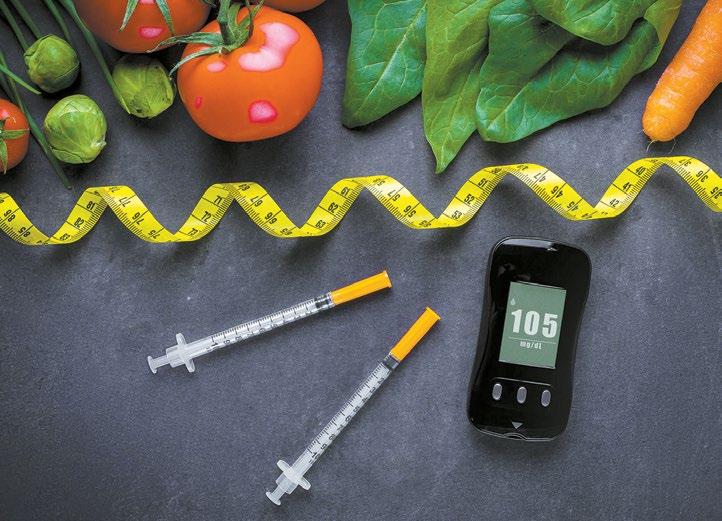
13 minute read
masters of bodywork & healing arts
Santa Rita Springs Dorothy Richmond, LMT Aquatic Massage Jin Shin Jyutsu Cranial Sacral Watsu

Advertisement
520 990 1857 www.SantaRitaSprings.com
TIME TO CATCH OUR BREATH



by Naomi Greene
As goes the breath, so follows the body and mind. It may sound simple, but most of us are seldom cognizant of our breathing pattern—even less so during moments of frustration or stress. One of the reasons that stress management, yoga, meditation or other practices work on breathing is that the breath is linked to every emotion we feel or express. When we are stressed or anxious, the first thing that changes is our breathing. The same is true when we’re happy or excited.
Think about it. When someone is depressed, breathing is shallow. When surprised or frightened, the ensuing “oh” is a quick inhalation. Crying elicits sobs, with long, sad exhalations and abrupt inhalations. Laughter is automatically accompanied by “ha, ha, ha”, quick in-and-out breaths. When we see a beautiful or peaceful scene, we may take a deep breath, as we visually take it in, then a slow exhalation: “Ahhhh.”
Yoga poses and meditation offer regular practice in developing breath awareness and focus. On a purely physical level, practitioners take conscious and deliberate control of the breath. In the long-term, they may expand lung capacity. However, on a deeper level, practitioners learn the difference between diaphragmatic breathing and upper lung breathing, and that the former can bring about emotional and physical health benefits.
We can start by simply being aware of our breath at any time of day or situation. Waiting in line at the DMV? Waiting at the pharmacy or store? Starting to feel angry? What is the breath doing? There’s a reason we have the saying “catch your breath”. Our emotions are linked to our breath. Our breathing is linked to our emotions.
Try this, whether sitting, lying down or in the car. If possible, close the eyes. • Take a long, slow breath to the count of four (1, 2, 3, 4). • Notice the pause. • Try to exhale to the same count of four. • Notice the pause before inhaling again. • Repeat a couple of times. • Resume normal breathing.
Another easy or simple way to observe the breath is to take note of how we are breathing while watching or listening to something that is emotionally charged, such as a news program, an action movie or drama show. What happens to our breath when we change the channel to a calmer or more peaceful program?
Why is our breathing pattern so important? Studies have shown that stress, which is related to the way we breathe, results in biochemical changes in the brain and body. In the short-term, these changes may result in increased adrenaline, cortisol or changes in levels of serotonin. On the other hand, there may be a production of endorphins (the biochemicals that help us feel happy) if we are feeling content. Or are we feeling content because of the production of these biochemical changes? Whatever the case, the breath is definitely involved.
Another breathing exercise to try: laughter. Making ourselves and/or someone else laugh can be contrived, even silly at first, but we’ll find it is contagious, and may truly get us laughing. It will change our breath, and maybe even our mood.
Beyond the link to emotions and helping practitioners to breathe better, disciplines such as yoga and meditation help to harness
Relaxation above and beyond
Personalized attention to your tension and pain patterns

Cheryl Foster
Natl. Bd. Cert. Reflexologist
520-345-4554
BarefootDreams.net
1661 N. Swan Rd., Ste. 254 Tucson, AZ. 85712
$10 off first session
Past Life Regression
QUANTUM HEALING HYPNOSIS for Ultimate Soul Enlightenment
Zoom Sessions
Available
BOOK A SESSION FOLLOW UP INCLUDED!
“My QHHT session ranks as one of the most enlightening events of my adult life.” -RMC Call now for Special Introductory Offer 201-759-6845 KrysteAndrews.com
the breath and focus the life energies known as prana, or chi. Yogis would say that the feeling of “being scattered” is a result of the prana being scattered. Focusing the breath helps to focus and direct these pranic energies.
By oxygenating our body, we can change our emotions. We can change our emotions by changing our breath. During stressful times—perhaps even the upcoming stressfilled holidays—we should take time to check in with our breathing and “catch our breath”.
Naomi Greene is a certified yoga teacher, freelance writer and member of The Yoga Connection. The nonprofit center offers classes year-round, seven days a week and live-streamed, including many levels of yoga, teacher training, meditation sessions and various workshops. Connect at
Experience Mobile
Thai Massage
An ancient healing modality from Thailand
Traditionally performed on the floor • Improve flexibility • Boost circulation • Improve body posture and alignment • Encourage deeper
Special breathing offer Book two massages in same
month; receive 20% off
20% 2nd massage off Hope Huerta Certified Massage Therapist 520-248-0590 • hopesamusonic@gmail.com
Mobile Services provided to limited areas
There Are Over 40 Different Losses A Person Can Experience In A Lifetime I can help you discover relief from your grief and pain
• One on one sessions • Online or in-person • 7-week action program • Evidence Based Method
Jennica S. Klemann
Advanced Certified Grief Recovery Specialist 6812 N. Oracle Rd. #100 • 520-850-8151
GriefReliefWithJennica.com

YogaConnection.org.

PREVENTING TYPE 2 DIABETES Natural Lifestyle Choices to Curb the Disease

by Marlaina Donato
Six decades ago, only one American in 100 had diabetes. prediabetes, 84 percent of whom are not aware of the fact, acToday, it’s almost one in 10, including rising numbers of cording to the U.S. Centers for Disease Control and Prevention. youth and one in four people older than 65. More than 90 A key player is the pancreas, a multitasking organ of both percent of the cases are Type 2, once known as adult-onset dia- the endocrine and digestive systems, which produces insulin to betes, which is linked to diet, obesity, inactivity, environmental help make and store energy from sugars, as well as enzymes to toxins, heredity and other factors. It can wreak havoc throughout break down proteins, fats and carbohydrates. While Type 1 diathe body—attacking blood vessels, eyes, nerves and organs—and betes, a genetic autoimmune disease, negates the body’s ability to make COVID-19 harder to combat. produce insulin, Type 2 results from an insufficient or improper
The good news is that scientists have identified lifestyle strat- use of insulin. egies that lower the risk and harm of diabetes. “Type 2 diabetes Type 2 diabetes can be triggered by metabolic syndrome, a is a condition, not a disease. It exists in a particular environment; condition marked by high blood pressure, a large waist circumwhen you change the environment, you can change the condi- ference and high triglycerides. Insulin resistance—the body’s tion,” says San Francisco-based Nicki Steinberger, Ph.D., author improper use of insulin—can also be a sneaky forerunner to the of Wave Goodbye to Type 2 Diabetes. That’s important news for disease, often manifesting as excessive abdominal fat, fatigue the one in three Americans—about 88 million people—that have and frequent infections years before hyperglycemia—too much
sugar in the blood—becomes evident.
“Diet and lifestyle play a tremendous role,” says Lauren Bongiorno, a virtual diabetes health coach and creator of The Diabetic Health Journal. “Increasing insulin sensitivity is a multi-prong approach, most notably influenced by improving circadian rhythm, reducing stress, eating lower glycemic carbs, reducing animal fats and increasing activity.”
Hidden Environmental Factors
The American Diabetes Association cites excess weight and lack of exercise as significant risk factors in the development of Type 2 diabetes, while recent studies also point to impacts from toxic air, chemicals and mercury exposure. Research published in 2018 in Environmental Science and Pollution Research International reveals a correlation between exposure to phthalates found in plastics and the incidence of new-onset Type 1 diabetes in children, suggesting that the loss of beta cells from phthalate exposure leads to a compromised insulin response.
“Plastics containing BPA can mimic estrogen (xenoestrogens) and can contribute to insulin resistance, insulin over-secretion, beta cell exhaustion and the development and progression of Type 2 diabetes,” says registered dietician and nutritionist Brenda Davis, the Alberta, Canada, author of The Kick Diabetes Cookbook and Kick Diabetes Essentials.
An earlier Indiana University study published in Diabetes Care showed young-adult exposure to mercury can raise the risk of developing Type 2 diabetes later in life by 65 percent. Davis adds, “Heavy metals, such as mercury and arsenic, have been linked to impaired insulin secretion and decreased insulin sensitivity.” Choosing organic produce and fish that contain lower levels of mercury, such as salmon, shrimp and catfish, is advised.
Medication Backlash
Improving gut flora is vital in improving most health conditions, including Type 2 diabetes. “Microbes in the gut that have become toxic for a multitude of reasons create an inflammatory response. This type of assault repeated over time increases the risk of fatty liver and compromised cells— conditions linked to a decrease in insulin sensitivity,” says Steinberger.
Research published in The Journal of Clinical Endocrinology & Metabolism suggests that antibiotic use, especially narrowspectrum ones, can contribute to diabetes. The side effects of certain medications like statins and other cholesterol-lowering drugs has been debated for decades, and 2019 research published in Diabetes Metabolism Research and Reviews concludes that statins can more than double the risk of Type 2 diabetes, especially for people taking them for two years or longer.
Sleep and Sugar
The National Sleep Foundation considers sleep deprivation a significant diabetic risk factor and recommends that people take melatonin as a sleep aid and avoid working night shifts. It cites a study in which healthy adults that were restricted to four hours of sleep for just six nights exhibited a 40 percent reduction in their ability to break down glucose.
Although the role of dietary sugar in diabetes is debated by scientists, evidence shows a strong correlation between Type 2 diabetes and sugar, fructose and highfructose corn syrup in the diet. A 2015 review of 21 studies published in The British Medical Journal found that regular intake of sugary beverages can lead to diabetic conditions even when obesity is not a factor. Many holistic health advocates identify all sweeteners, including “healthy” alternatives like honey and maple syrup, as sugars that harbor similar potential.
This mindset is harmonious with


glycemic index recommendations, so avoiding any added sweeteners and opting for fresh, low-glycemic fruits like berries, citrus and apples, as well as eschewing pasta, white rice and bread, can go a long way toward maintaining healthier blood sugar levels. Stevia, an herb, is a better sweet substitute. Preferable in drops or bulk form rather than blended with sugars, it’s been shown to help control blood sugar.
Promising Phytotherapy
Insulin-supporting medicinal herbs offer many benefits for Type 2 diabetics. Aloe vera, bilberry, cinnamon, goldenseal, bitter melon, milk thistle, fenugreek, fennel and gymnema sylvestre, among others, have been found to aid in the utilization and production of insulin. Tulsi, also known as holy basil, is a heavy hitter for reducing blood glucose and buffering the kidneys and liver from the metabolic side effects of high blood sugar. Herbs that support the liver, such as milk thistle, dandelion and artichoke, are other noteworthy plant medicines, especially when blood sugar fluctuates from high to low.
Renata Atkinson, a clinical herbalist in Greenbelt, Maryland, says of blood tests, “Clinical trials have shown that many of these herbs can have a significant effect on the clinical markers for diabetes and prediabetes in fasting blood glucose, postprandial glucose and HbA1C, or glycosylated hemoglobin.” Animal and in vitro studies show that they impact blood sugar by slowing digestion and the absorption of carbohydrates, thereby improving insulin sensitivity, increasing the release of insulin and modulating the metabolism of glucose in the liver. Some of Atkinson’s favorite plant allies are hawthorn, hibiscus and tilia for their anti-inflammatory and antioxidant properties, as well as lipid, glucose and vascular support. Atkinson also emphasizes the wisdom of keeping it simple. “I encourage clients to incorporate culinary herbs and spices into their daily diet, like cinnamon, fennel, garlic and onions. For someone taking insulin, it’s important to introduce herbs slowly and be sure to take them with meals, monitor blood glucose levels closely and keep their physician informed of herbal protocols and follow their physician’s recommendations.”
Improving diet choices can be highly rewarding and fun, too. “Not only does eating well not have to be tortuous, it can be enjoyable, inspiring and creative,” says Steinberger.
“It helps to keep it simple by using fresh, whole foods with basic herbs and spices.”
Vitamin D, magnesium, vitamin C, B complex and chromium are also valuable in managing Type 2 diabetes. Polyphenols—antioxidants found in tea and unsweetened cacao nibs—also pack a healthy punch. Alpha lipoic acid, found in broccoli, spinach and fish oil, can help to reduce inflammation. Berries, kale and other nutrient-packed greens, nuts, sweet potatoes and beans promote sugar balance and are versatile for delicious, healthy meals.
Whole-Body Healing
Holistic bodywork modalities such as acupuncture also support diabetic health. In 2019, Iranian researchers reported in the journal Hospital Practices and Research that biofeedback training lowered glucose levels and improved the quality of life for diabetic patients. “The biggest mistake I see people with diabetes make is to view the mental piece as not as important as the physical,” says Bongiorno.
Linking all the vital threads in the complex web of Type 2 diabetes, she adds, “I would say to start with the basics—plant-based foods, exercise, stress management and better sleep. When you have a solid base, your body will be less susceptible to the other factors.” Thriving is possible through commitment and wise choices. As Davis says, “There is strong and consistent evidence that many people who are motivated to reverse Type 2 diabetes can succeed in this task.”
Marlaina Donato is the author of several books and a composer. Connect at AutumnEmbersMusic.com.
Diabetic Strategies to Consider
Glucose balance is a diabetic’s life struggle. We all know to keep our sugars down, eat right and exercise. Here are some basic strategies to consider.
• Eat low glycemic foods every two hours. This keeps the metabolism on a slow burn, keeping glucose low. • Exercise. Burn that glucose. Any exercise is good, but cardio is best.
Try a 30-minute walk per day or higher intensity cardio with cycling, swimming or running for 30 to 60 minutes, two or three times per week. Weight training builds muscle, which burns glucose. • Rest. Get enough sleep to let the body recover. • Consider drinking green tea and cinnamon, which have been shown to lower blood glucose. • Adopt a positive mental attitude. This helps brain chemistry and ignites the metabolism.
These simple strategies will go a long way toward preventing diabetes and managing it. Get educated on the glycemic index, eat smart, exercise, rest, stay positive and be happy.
Dr. Nathan Conlee of Winterhaven Health Center has been treating auto and sports injuries since 1987. As a Chiropractic Neurologist, he works with many neurologic disorders, using gentle chiropractic, physiotherapy, acupuncture and metabolic nutrition. Mention this article to get a $93 discount on initial examination. Connect at 520-322-6161 or PerformanceNeurology.com. See ad, page 23.

goffkein/Pexels.com
EXCLUSIVE CONTENT ONLINE @NaturalTucson.com
NATURAL BEAUTY Homemade Solutions for Glowing Skin BODY GRATITUDE Being Thankful Empowers Our Workouts
MINDFUL PARENTING The Conscious Path to Raising a Child
SKINSOOTHING HERBS FOR DOGS AND CATS Simple Ways to Reduce Itching











